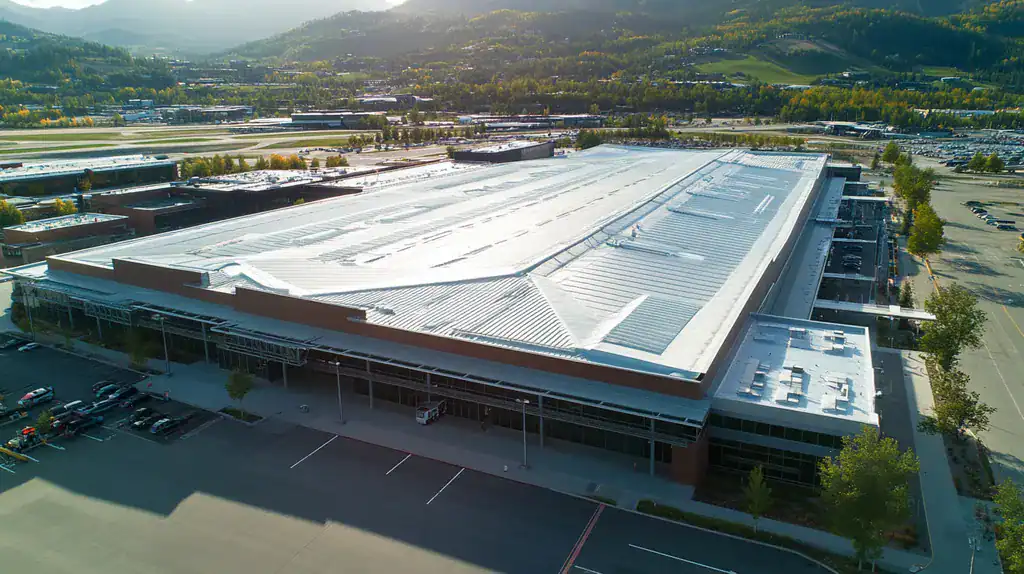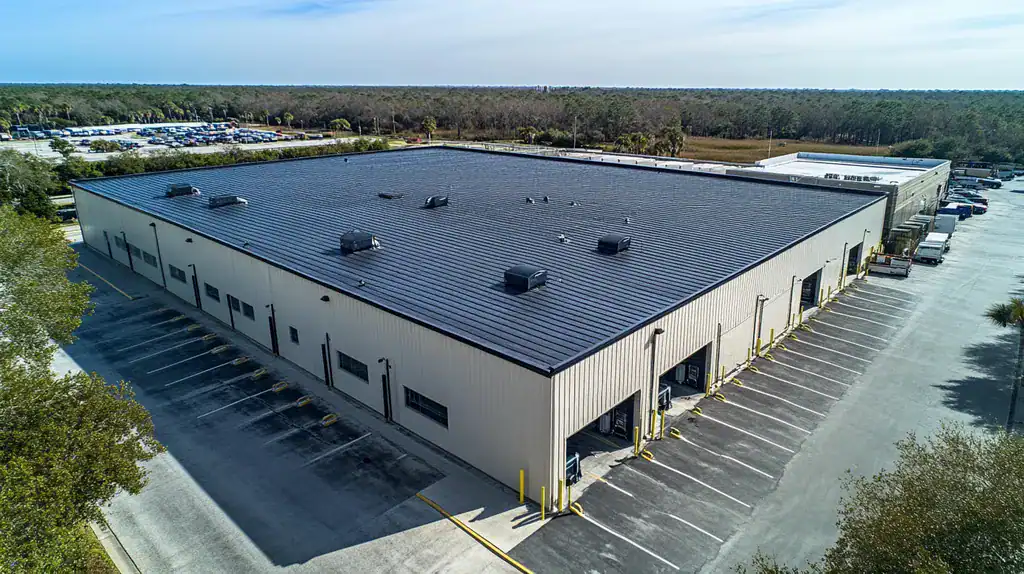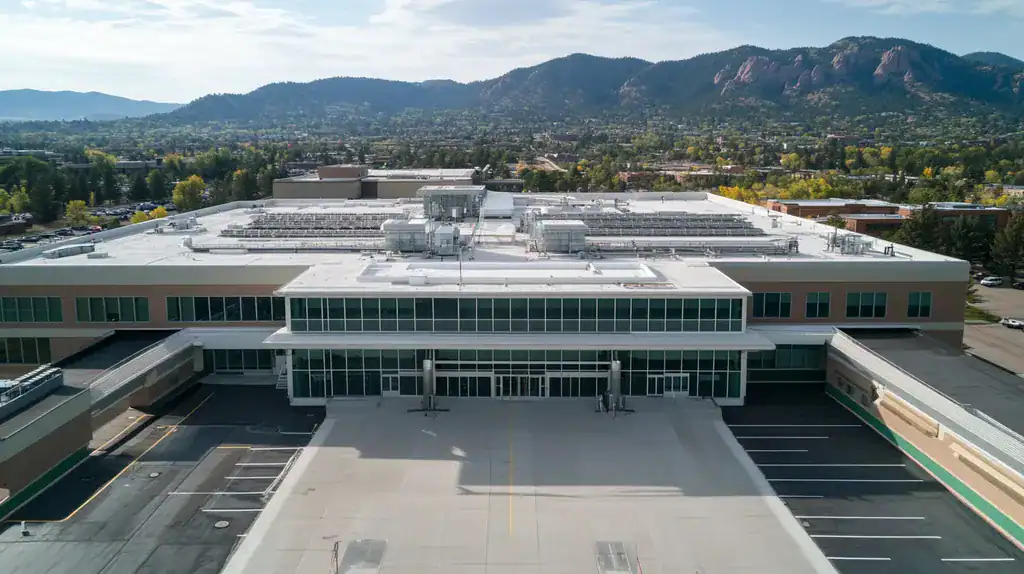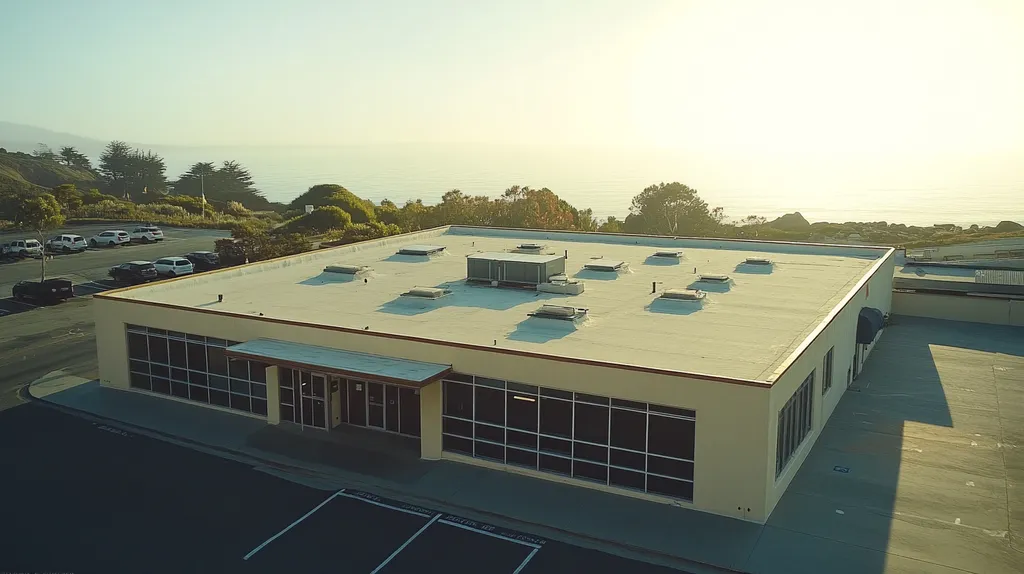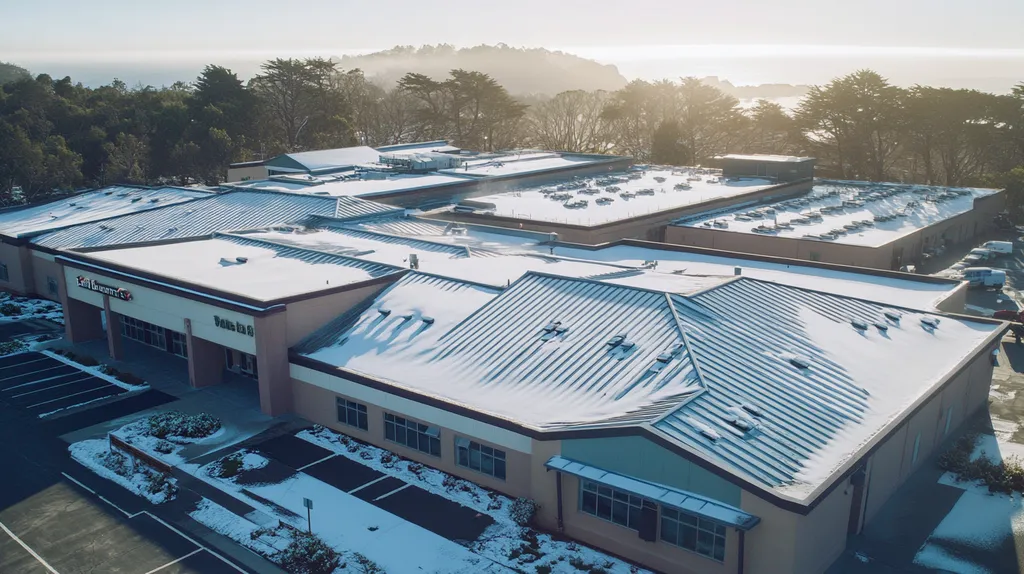The explosive growth in commercial solar installations has created an urgent structural challenge: over 40% of commercial roofs lack adequate capacity for unplanned solar panel loads.
As businesses rush to adopt renewable energy solutions, many overlook the critical relationship between solar array weight and roof structural integrity. A typical commercial solar installation adds 3-6 pounds per square foot of dead load, potentially pushing aging roof systems beyond their design limits.
This comprehensive guide examines the complex interplay between solar panel systems and roof load capacity, providing facility managers with essential strategies for safe, efficient solar adoption.
SECTION 1: FUNDAMENTAL CONCEPTS
The surge in commercial solar installations has created an urgent need for building owners to understand rooftop weight dynamics. With energy costs climbing and sustainability mandates increasing, many facilities are rushing to install solar arrays without proper structural evaluation. This oversight can compromise both roof integrity and building safety, making it crucial to understand the relationship between solar panel systems and roof load capacity.
Solar Panel Basics Explained
Commercial solar installations represent significant weight that must be carefully distributed across rooftop surfaces. A typical commercial solar panel measures 6.5 feet by 3 feet and weighs over 50 pounds, substantially more than residential panels. (source: EnergySage)
Beyond the panels themselves, mounting racks, ballast blocks, and electrical equipment add considerable weight to the system. These components can double or triple the total load placed on the roof structure.
Weather conditions further impact the effective weight of solar arrays. Rain, snow, and ice accumulation between and beneath panels can create additional loads that must be factored into capacity calculations.
The positioning of panels also affects weight distribution. Tilted arrays create point loads at specific attachment locations, while flat installations spread weight more evenly across the roof surface.
Roof Weight Capacity Considerations
Every commercial roof has a specific dead load capacity – the maximum weight it can safely support beyond its own structural components. This capacity varies dramatically based on building design, age, and construction materials.
Steel deck roofs typically support between 20 and 25 pounds per square foot, while concrete deck systems can handle significantly more. However, these ratings assume evenly distributed loads rather than concentrated weights.
Existing rooftop equipment, HVAC units, and other installations already consume part of the available load capacity. This remaining capacity determines whether solar panels can be safely added.
Regular structural assessments become crucial after solar installation, as settling and material fatigue can reduce a roof’s weight-bearing capability over time.
System Design Principles Overview
Effective solar installations begin with comprehensive structural engineering analysis. This process identifies optimal panel placement zones and determines whether reinforcement is needed.
Load distribution techniques, such as wider mounting rails or additional support points, can help spread weight more evenly across the roof surface. These methods prevent stress concentration at specific points.
Strategic panel arrangement should account for existing roof features and drainage patterns. Proper spacing ensures maintenance access while maintaining structural integrity.
Monitoring systems can track structural performance over time, alerting facility managers to potential issues before they become critical. This proactive approach helps protect both the solar investment and the building itself.
SECTION 2: SYSTEM COMPONENTS
Commercial solar installations represent a significant investment that demands careful consideration of component selection and weight distribution. Recent industry data shows that over 60% of commercial roof failures related to solar installations stem from improper component selection or placement. Understanding the critical elements of a solar system – from panels to mounting hardware to electrical components – is essential for maintaining structural integrity while maximizing energy production.
Solar Panel Types and Selection
The selection of appropriate solar panels directly impacts both system performance and structural requirements. Modern commercial solar installations typically use 72-cell panels that can weigh 50 pounds or more, with final weight varying based on material composition and manufacturer specifications. (source: Velosolar)
Three primary panel types dominate the commercial market: monocrystalline, polycrystalline, and thin-film. Monocrystalline offers the highest efficiency but comes with premium weight and cost considerations.
Polycrystalline panels provide a middle-ground option, balancing moderate efficiency with more manageable weight profiles. These panels often present the most cost-effective solution for large commercial installations.
Thin-film technology, while less efficient, offers significant weight advantages and flexibility in installation. This option proves particularly valuable for buildings with limited structural capacity.
Mounting System Options Review
Mounting systems serve as the critical interface between solar panels and roof structure. The choice between ballasted and penetrative systems significantly affects overall installation weight and distribution patterns.
Ballasted systems rely on concrete blocks or other weighted materials to secure panels without roof penetration. While this approach preserves roof membrane integrity, it adds substantial weight that must be carefully calculated into load requirements.
Penetrative mounting systems attach directly to structural elements through the roof surface. These systems typically weigh less than ballasted alternatives but require precise installation to maintain waterproofing integrity.
Hybrid mounting solutions combine both approaches to optimize weight distribution while ensuring system stability. These systems require detailed engineering analysis to balance security and structural impact.
Inverter and Electrical Components
The electrical infrastructure supporting solar installations adds meaningful weight considerations beyond panel systems. Central inverters, wiring conduits, and junction boxes must be strategically placed to distribute loads effectively.
String inverters represent the traditional approach, centralizing power conversion in larger units. While these systems minimize component count, they create concentrated load points that require careful structural planning.
Microinverter systems distribute conversion equipment across the array, potentially offering better weight distribution. However, the increased number of components demands thorough load calculation and placement strategy.
Electrical raceway systems and cable management solutions contribute additional weight that must be factored into overall capacity calculations. Proper planning ensures these components enhance rather than compromise system integrity.
SECTION 3: IMPLEMENTATION METHODS
The successful installation of commercial solar arrays hinges on selecting appropriate implementation methods that respect roof load limits. Recent industry data shows that improper installation techniques account for over 40% of solar-related roof failures. Property owners and facility managers must understand how different mounting systems, installation approaches, and preparation methods impact their building’s structural integrity.
Rail and Rail-Less Mounting Techniques
Rail mounting systems create a framework of aluminum or steel supports that distribute panel weight across multiple attachment points. These systems add 2-3 pounds per square foot to the total load but provide superior stability and simplified maintenance access.
Rail-less systems eliminate the support framework, reducing overall weight and installation complexity. This approach requires precise panel placement and typically costs less due to reduced materials.
The choice between rail and rail-less systems depends heavily on roof configuration and existing load capacity. Flat roofs often benefit from rail systems that facilitate water drainage, while steep-slope applications may favor rail-less solutions.
Both methods require careful engineering to ensure proper load distribution and prevent stress concentration at attachment points. Regular inspections help identify potential issues before they compromise system integrity.
Ballasted vs. Anchored Installation
Ballasted systems secure panels using concrete blocks or other weighted materials, eliminating the need for roof penetrations. This method simplifies installation but can add significant weight, often exceeding 5 pounds per square foot in ballast alone.
Anchored installations attach directly to the building’s structural components through carefully waterproofed penetrations. This approach minimizes additional weight but requires precise installation to maintain roof membrane integrity.
Hybrid solutions combining both methods often provide optimal results by balancing weight distribution with system security. These systems use fewer ballast blocks while maintaining stability through strategic anchor points.
Local wind conditions and building height significantly influence the choice between ballasted and anchored systems. Higher elevations typically require more secure anchoring to withstand increased wind loads.
Roof Preparation Best Practices
Proper roof preparation begins with a comprehensive structural assessment to verify load-bearing capacity. This evaluation must account for existing equipment, anticipated solar components, and potential snow accumulation in winter months.
Surface preparation involves removing debris, repairing damaged areas, and ensuring proper drainage patterns. Any existing leaks or structural weaknesses must be addressed before installation begins.
Clear access paths for maintenance and emergency response must be incorporated into the layout design. These pathways should distribute foot traffic loads effectively while protecting both the roof membrane and solar components.
Documentation of existing conditions, including detailed photographs and load calculations, provides crucial baseline data for future reference. This information helps track structural performance and identify potential issues over time.
SECTION 4: MAINTENANCE REQUIREMENTS
The addition of solar panels fundamentally changes how commercial roofs must be maintained and monitored. While these systems offer substantial energy benefits, they create new maintenance challenges that facility managers must proactively address. Without proper oversight, the combined weight of solar equipment and maintenance personnel can stress roofing systems beyond their design limits, potentially compromising both the roof’s integrity and the solar investment.
Regular Inspection Procedures
A typical commercial roof must support both the permanent weight of solar installations and temporary loads from maintenance activities. The minimum live load requirement of 20 pounds per square foot applies specifically to maintenance personnel and equipment, separate from the dead load of the solar array itself. (source: Olson Solar Energy)
Inspection schedules should be established based on system size and complexity. Most commercial installations require quarterly visual assessments and annual comprehensive evaluations.
Key inspection points include mounting hardware integrity, roof membrane condition around penetrations, and signs of water pooling. Special attention must be paid to areas where maintenance traffic creates repeated stress.
Documentation of each inspection should include weight distribution maps, identifying both permanent installations and temporary maintenance zones. This helps prevent overloading during service activities.
Cleaning and Repair Techniques
Safe cleaning procedures must account for combined equipment and personnel weight. Mobile cleaning platforms and lightweight tools help minimize point loading during maintenance.
Water management during cleaning requires careful consideration. Drainage patterns may change as panels collect and redirect water flow, potentially creating new stress points.
Repair strategies must incorporate both immediate fixes and preventive measures. This includes reinforcing high-traffic maintenance paths and protecting vulnerable attachment points.
Equipment staging areas should be clearly designated and rotated to prevent concentrated wear. These zones must be engineered to handle both stored materials and worker activity.
Performance Monitoring Strategies
Digital monitoring systems provide real-time data on system performance and structural integrity. Load sensors can track weight distribution patterns across the roof surface.
Regular performance metrics should include both energy generation efficiency and structural stability indicators. Declining output often signals maintenance issues requiring attention.
Weather monitoring becomes crucial for maintenance planning. High wind conditions or snow accumulation can significantly impact both dead and live loads.
Integration of monitoring data helps optimize maintenance scheduling and resource allocation. This ensures that service activities maintain system performance while protecting roof integrity.
SECTION 5: PERFORMANCE METRICS
The integration of solar panels on commercial roofs demands rigorous performance tracking to protect both energy generation potential and structural integrity. Recent market analysis shows that over 30% of commercial solar installations underperform due to inadequate monitoring and metric analysis. Understanding and tracking key performance indicators ensures that rooftop solar investments deliver expected returns while maintaining building safety.
Energy Output and Efficiency Measures
Energy output measurement begins with understanding panel specifications and real-world performance variations. Commercial panels require significant roof space, with typical units measuring 6.5 feet by 3 feet and weighing over 50 pounds each. (source: EnergySage)
Environmental factors like shade patterns, dust accumulation, and panel orientation can reduce theoretical output by 15-25%. Regular monitoring helps identify these efficiency drains before they significantly impact system performance.
Temperature fluctuations directly affect panel efficiency, with most systems losing 0.5% efficiency for every degree above optimal operating temperature. Proper roof ventilation and panel spacing help maintain ideal operating conditions.
Digital monitoring systems should track both instantaneous power output and cumulative energy production. This data helps identify gradual efficiency declines that might indicate mounting system issues or roof structure concerns.
System Reliability and Uptime Tracking
Reliability metrics focus on system availability and consistent power generation capacity. Key indicators include inverter performance, connection integrity, and panel degradation rates over time.
Weather-related downtime must be carefully documented to distinguish between unavoidable interruptions and system failures. This analysis helps optimize maintenance schedules and identify vulnerable components.
Structural monitoring should track settling patterns and stress point development. Early detection of mounting system movement or roof deflection prevents cascading performance issues.
Integration with building management systems enables automated alert protocols when performance metrics fall below predetermined thresholds. This proactive approach minimizes revenue loss from system inefficiencies.
Cost Savings and ROI Analysis
Comprehensive ROI calculations must consider both direct energy savings and indirect benefits like reduced roof maintenance costs. Initial analysis should establish clear baseline metrics for comparing pre- and post-installation expenses.
Load redistribution effects on HVAC efficiency often create additional savings through improved roof insulation and reduced heat island effect. These secondary benefits can significantly impact total return calculations.
Warranty coverage and maintenance contracts should be factored into long-term cost projections. Well-maintained systems typically extend both panel and roof life expectancy by 15-20%.
Regular financial performance reviews should track actual versus projected savings, adjusting maintenance budgets and replacement schedules accordingly. This dynamic approach ensures optimal system economics throughout the installation lifecycle.
SECTION 6: OPTIMIZATION STRATEGIES
Modern commercial solar installations require sophisticated optimization strategies to balance maximum energy production with roof structural integrity. Studies show that poorly optimized systems can reduce energy yield by up to 30% while creating dangerous load concentrations. As energy costs continue rising and sustainability mandates tighten, facility managers must implement comprehensive optimization approaches that protect both their energy investment and building structure.
Panel Orientation and Angling Strategies
Panel orientation and tilt angles directly impact both energy generation and structural loading patterns. Proper configuration maximizes sunlight capture while ensuring even weight distribution across roof surfaces.
Advanced modeling software now enables precise calculations of optimal panel positioning based on building location, roof geometry, and local weather patterns. These tools help prevent both energy losses and structural strain.
Seasonal adjustments in panel tilt can increase annual energy yield by 5-15%. However, any modification must account for resulting changes in load distribution and wind resistance.
Wind uplift forces become particularly critical when optimizing panel angles. Higher tilt degrees create greater sail effects, potentially requiring additional structural reinforcement or modified mounting strategies.
Integration with Building Management Systems
Modern building management systems (BMS) serve as the central nervous system for optimizing solar installation performance. These platforms monitor both energy production and structural impacts in real-time.
Load sensors integrated with BMS can detect subtle changes in weight distribution patterns. This early warning capability helps prevent structural issues before they compromise roof integrity.
Smart monitoring systems track performance metrics against weather conditions and energy demand patterns. This data enables dynamic adjustments that maximize efficiency while maintaining safe loading parameters.
Automated alerts notify facility managers when conditions approach predetermined structural or performance thresholds. This proactive approach prevents both energy waste and potential roof damage.
Energy Storage and Backup Solutions
Battery storage systems add crucial flexibility to rooftop solar installations. These components must be strategically positioned to complement existing load patterns rather than create new stress points.
Distributed storage solutions can help balance structural loads while providing enhanced energy management capabilities. Smaller battery units spread across the roof often prove more practical than centralized systems.
Integration of microinverters with storage systems enables granular performance optimization. This approach maximizes energy capture while minimizing the impact of individual component failures.
Emergency backup systems require careful placement to maintain structural integrity during extreme weather events. These critical components often benefit from dedicated reinforcement zones within the overall roof structure.
Looking Ahead
The integration of solar panels on commercial roofs represents both unprecedented opportunity and significant risk, with industry data showing 40% of installations currently operating below optimal efficiency due to structural compromises.
As renewable energy adoption accelerates, facility managers must prioritize comprehensive weight analysis and ongoing structural monitoring to protect their solar investments.
The stakes are clear: improper load management can transform a sustainable energy solution into a liability that threatens both building integrity and occupant safety.
Success requires a holistic approach combining careful system design, proactive maintenance, and sophisticated monitoring protocols to ensure solar installations enhance rather than endanger commercial properties.
The future of commercial solar depends on striking this crucial balance between energy production and structural preservation.
FREQUENTLY ASKED QUESTIONS
Q. How do solar panels affect commercial roof weight capacity?
A. Solar panels add significant weight to commercial roofs, which requires careful evaluation. Without assessing structural load capacity, installations can jeopardize roof integrity and safety.
Q. What components should I consider for my industrial roof solar system?
A. Key components include solar panels, mounting systems, and electrical systems. Proper selection and placement of these components ensure safety and optimal energy performance.
Q. What implementation methods are best for commercial roofs?
A. Best methods include rail and rail-less mounting systems. Each approach has advantages and should consider existing load capacity and building design.
Q. How can I maintain a commercial roof with solar panels?
A. Regular inspections and careful cleaning are essential for maintenance. Monitoring weight loads from personnel and equipment can help protect roof integrity.
Q. What performance metrics should I track for solar panels?
A. Track energy output, system reliability, and cost savings. Monitoring these metrics ensures your solar investment provides expected returns and maintains building safety.
Q. How do I optimize energy production on my commercial roof?
A. Optimize panel orientation and integrate with building management systems. These strategies maximize energy output while ensuring structural integrity is maintained.
Q. Are there any specific regulations for solar panels on roofs?
A. Yes, regulations vary by location. It’s essential to check local codes concerning structural load, permitting, and safety standards for solar installations.

